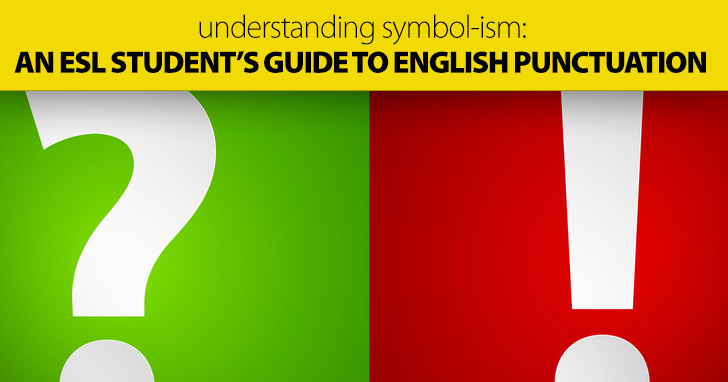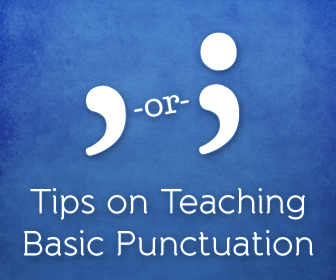Understanding Symbol-ism: an ESL Studentís Guide to English Punctuation


There are a lot of rules, but if you follow these tips on teaching the basics of punctuation, your students will go from befuddled to enlightened.

You really don’t have to be an expert writer or a college graduate to be able to punctuate a sentence correctly. Language learners in particular tend to overlook punctuation because they have so many other aspects to focus on and sharpen. Grasping basic punctuation rules, like when to use a comma, will not just serve students well in writing, but also in reading, testing, and believe it or not, speaking. So what is the big deal about this little guy, the comma? Well, it is often overused, misplaced, mistaken and kicked around without much regard as to why! One way to eliminate the confusion is to look at the main job of a comma. A comma is a pause. It is used to slow us down, lets us place emphasis where it needs to go, and allows us to write more complex sentences. With language learners, the best way to introduce punctuation rules is to go slowly and methodically. Introduce one or two points and practice them in all sorts of different ways. Only introduce the next rule or lesson when the previous one has been mastered. The first two rules to introduce regarding the comma are described here.
| Rule One: | A comma is used to separate a series of three or more words, phrases or clauses |
| Examples: | I like to eat pizza, chocolate, apples, and donuts. We spoke on the phone in the morning, in the evening, and again late at night. The boys went to the baseball game, the arcade, and then to band practice. I haven’t traveled to Paris, studied French, or met any French people. |
A good way to practice this point is to illustrate series that contain not just words, but also clauses, and phrases. You can do it first on the board and have students come up and place commas where they need to go. Using cards with words on them and having students put the cards in the correct order with punctuation is also a good hands-on puzzle-like activity. Another way to make that more fun is to make the cards larger and have the students physically move themselves (with their cards) around to get into the correct order. It is a great visual activity that will be memorable for everyone!
| Rule Two: | A comma is used to separate two independent clauses that are joined by conjunctions such as but, and, nor, for, yet, or so. |
| Examples: | I would go with you, but I have too much work to do. He is a great artist, and he loves his work. I’m still angry with Sue, so I don’t want to see her. |
The best and most significant way to introduce this comma rule is to illustrate that you are taking two sentences and combining them with a comma and a conjunction. Doing this at first on the board and then followed by some hands-on practice is a good starting point. Have them write a description of their day with little to no punctuation. Then have them work in pairs to decide where to put commas, periods, and capitalization.
Everyone hates the poor little semicolon. It baffles even us native speakers, and when we do attempt to use, we feel uncertain. So imagine how your language learners feel! The semicolon is also just not used that much. Maybe we prefer to avoid it and find ways around it. The two rules to introduce first are described here.
| Rule One: | Use a semicolon to combine two very closely related complete sentences. |
| Examples: | Don’t go in the water; it is contaminated. The CEO spoke at the conference; he told us no one would get laid off. Call me in the morning; I will give you my answer then. |
| Rule Two: | Use a semicolon along with a conjunctive adverb and a comma to clarify the relationship between two closely related complete sentences. Conjunctive adverbs include however, therefore, in addition, moreover, subsequently, consequently, instead, and additionally. |
| Examples: | Jane called in sick again today; therefore, the boss is going to let her go. The bridge is collapsing; however, engineers are working day and night to fix it. |
Both of the above rules will take a lot of practice and examples to solidify understanding for students. Use strong examples and then solicit examples from the students to get them involved. Be sure to point out the lack of punctuation after the semicolon, and that both of these rules must contain very closely related subject matter. After you have done lots of examples, give them a passage of writing that has all the punctuation removed from it. Let them work together to add in commas, semicolons, periods and any other punctuation they know. Another good exercise is to have students generate their own sentences with no punctuation and have their partner or the class put in the correct forms. Also, this is the time to pull out the grammar books and give them some drills for homework.
The period is a pretty friendly element and known to most students. You can’t do much reading without figuring it out. You could do activities in which you introduce questions marks, exclamation marks, and periods and test students on determining when each should be used. Because they are so common, often students have a good idea of when to use them. After you have introduced some comma and semicolon rules, it is a great idea to review all types of punctuation by challenging students with cut-up stories, editing paragraphs, or attempting to write an error-free paragraph.
Remember to keep reinforcing old and new rules, build upon what they know, and make it entertaining.